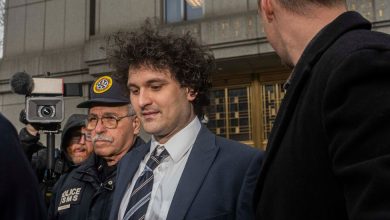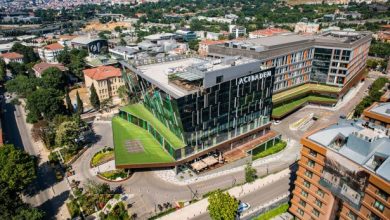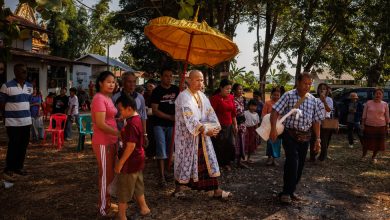The Bumpy Road to a Group-Led Documenta

KASSEL, Germany — Every five years, the international art world descends on this orderly, prosperous city for Documenta, considered the world’s most important contemporary art exhibition.
The 2022 edition, which opens June 18, is curated by the Indonesian art collective ruangrupa; it is the first time Documenta’s artistic direction has been given to a group. More artists, and more from the global south, are taking part than ever before. Yet the road to this year’s Documenta, the 15th, has not been smooth: Fraught weeks before the opening gave a taste of the organizational challenges and political risks of bringing together a vast array of artists of disparate origins and diverse perspectives.
Ruangrupa invited 14 other collectives to participate in the 100-day show, which is viewed as a barometer for the direction of art and a mirror of society; those groups, in turn, asked more groups to join them. The result of this maze of connections, according to Farid Rakun, a ruangrupa member, is that the number of participating artists runs into the thousands.
“This is not fully controllable,” Rakun said in an interview. “That’s fine, we don’t want to control.”
Among the developments out of ruangrupa’s control has been a heated debate about antisemitism and racism that erupted in the German press months before the exhibition opening. On an organizational level, the curators’ collective approach clashed with Documenta’s hierarchical structures. And from a logistical point of view, Germany’s rigid rules-based administration has had to show flexibility to meet artists’ needs.
This Documenta also challenges western preconceptions about who gets to show their work at prestigious contemporary art events.
The exhibiting collectives all pursue social or environmental missions on a local level in their homelands. Wajukuu Art Project, for instance, holds art classes for children in Mukuru, a deprived district of Nairobi, Kenya, where many residents scavenge from a dump or turn to petty crime for survival. The group is bringing a sense of Mukuru to comfortable Kassel: a pitch-dark tunnel filled with Nairobi street sounds will lead visitors into the main exhibition space, the Documenta Halle.
Another participant, Baan Noorg Collaborative Arts and Culture, works with monks and dairy farmers in a rural area of western Thailand to promote sustainability and preserve local cultural traditions. That group has set up a skateboard ramp and a shadow-puppet theater in the Documenta Halle.
Other participants’ causes are more vexed, at least here in Germany. The decision to include a Palestinian collective called The Question of Funding, whose work explores the ways Palestinian artists finance their practice, has been a source of strife. In January, a group called Alliance Against Antisemitism Kassel published a blog post in which it accused members of ruangrupa, the Documenta artistic team and the Palestinian collective of sympathy with the Boycott, Divestment and Sanctions movement against Israel. In 2019, Germany’s Parliament declared that movement antisemitic, saying its campaigns recalled “the most terrible chapter in German history.”
The blog’s accusations were picked up by German newspapers, and some opinion writers added their own assumptions. Pointing out that ruangrupa members are predominantly Muslim, Stefan Trinks commented in the Frankfurter Allgemeine Zeitung newspaper that their “awareness of Jewish concerns may be rather underdeveloped.”
Documenta first opted to address the controversy with a series of public discussions in May. But before the event could take place, Josef Schuster, the president of Germany’s Central Council of Jews, wrote a letter to Germany’s culture minister, Claudia Roth, criticizing Documenta’s plan to include a discussion of anti-Palestinian racism at the event. The organizers decided to postpone the talks until after the exhibition opens.
Ruangrupa published an open letter in response: “To be clear: no antisemitic statements of any kind have been made in the context of Documenta 15,” the statement read. “We strongly reject these accusations and refuse to accept bad-faith attempts to delegitimize artists and preventively censor them on the basis of their ethnic heritage and presumed political positions.”
In an apparent bid to calm the storm, Roth issued a joint statement with Schuster on May 13, cautioning that Germany’s “special responsibility in the fight against antisemitism” required “particular sensitivity in discussions at and about Documenta.”
But the discussion has shown no signs of abating: Felix Klein, the official in Germany’s government charged with fighting antisemitism, said in a newspaper interview published May 29 that the absence of Israeli artists at Documenta could trigger speculation they had been boycotted. The same weekend, an unidentified intruder or intruders broke into the former Kassel nightclub where The Question of Funding is exhibiting and graffitied the walls. Ruangrupa described the attack as “a politically motivated threat”; Documenta has filed a criminal complaint.
With so many diverse groups with a social or political agenda, perhaps some conflict is perhaps inevitable. “These are people who, together with their art, are trying to change things,” said Sabine Schormann, Documenta’s general director.
The basis of ruangrupa’s curatorial concept is the “lumbung,” an Indonesian barn used to store the surplus of a rice harvest before the community makes collective decisions on how to allocate it. To create a lumbung in Kassel, ruangrupa first invited 14 artist collectives from around the world to present work at Documenta. Those collectives in turn invited more than 50 individual artists and groups to join in, and all the participating artists were then organized into 10 “mini-majelis,” or small meeting groups, to ensure that everyone was included in planning the show.
Eszter Szakacs, a member of OFF-Biennale Budapest, another group showing in Documenta, said ruangrupa’s approach contrasts with the usual group exhibition experience, where artists work individually on their own contribution with little knowledge of what the others are doing.
“It’s very rare for artists to be included in all kinds of decision-making processes,” she said. “We are part of the ecosystem.”
Schormann said ruangrupa’s emphasis was on the process, not the results, and that those were “not at all predictable.”
“We are learning an incredible amount from each other — it’s very fruitful but very demanding,” Schormann said. “There are many participants from very different cultures with other perspectives to integrate.”
Yet this vision of global resource-sharing and joint decision-making has frequently run up against Germany’s rules-based society. Wajukuu Art Project’s pitch-black tunnel at the entrance to an exhibition hall, for instance, challenged the country’s health and safety regulations.
“We had a lot of meetings about that and we had to explain down to the smallest detail what we are doing,” said Ngugi Waweru, a Wajukuu Art Project member.
Tuan Mami, a member of Nha San Collective, another exhibiting group, said its contribution to Documenta was “semi-illegal.” The collective has created a work called “Vietnamese Immigrating Garden” from seeds donated by Vietnamese people in Germany. The plants, which aren’t native to Germany, were originally introduced by Vietnamese people living in the country, he said. “By law, you are not allowed to bring seeds in,” he said. “But the Vietnamese are very close to our plants, not just for eating: They are symbolic for the home, and family, and memories.”
Some of the Haitian participants in Documenta had no passports, and short-stay visas within the European Union are generally only awarded for 90 days. “We needed more like five months,” Schormann said. “There were lots of these kinds of conflicts,” she added. (Germany’s foreign ministry supported Documenta by helping to obtain visas for artists who needed to stay longer, a Documenta spokeswoman said.)
Adding to these challenges, most of the preparation took place during the pandemic. After debating whether to push Documenta back by a year, the organizers decided to forge ahead as planned. With international travel restricted, much of the preparation had to be done online.
The 10 mini-majelis were organized according to the time zones in which their members lived, so that the participants could convene via video conference. Each group was allocated a “collective pot” of money, separate from the production costs for their artworks, and had to decide how to spend it.
Some chose to help other participants with travel costs; one has opted to hold a party on June 22 on the square in front of the Fridericianum, Kassel’s main art museum. For that event, the Nest Collective of Kenya will manage the bar, the Nha San Collective of Vietnam is running the karaoke, the Thai group Baan Noong is in charge of food, Fehras Publishing Practices of Berlin is providing the music and the Romanian artist Dan Perjovschi is organizing games.
In keeping with ruangrupa’s commitment to local communities, participants have also used Documenta funding for projects in their homelands. Perjovschi, a cartoonist who is presenting a work at Kassel’s main train station, will give some of his Documenta budget to a theater festival opening June 24 in his hometown Sibiu, Romania. His budget has also financed an exhibition about Documenta at the local library there, and a number of art shows in locations ranging from Sibiu’s zoo to a shopping mall.
“It’s too expensive for a lot of people to come here from Romania, so we try to bring Documenta there,” Perjovschi said.
Founded after World War II in a bid to reclaim Germany’s place as a cultural nation, Documenta has often “revealed much not just about the direction of art, but also about the zeitgeist in broader terms,” said Dorothea von Hantelmann, a professor of art and society at Bard College Berlin.
That raises the question of how to interpret this edition, with its collaborative approach and social missions.
“The art practices here are applied in the service of other matters, whether environmental, social, or economic,” Hantelmann said.
“Great art is perhaps not in the foreground, at least not in the western 20th-century understanding, which is based on the cult of the individual,” she added. “Perhaps the 21st-century understanding of art will be something different.”





